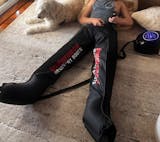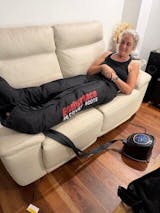Can Compression Boots Help With Tight Calf Muscles?

Did you know that 70% of athletes use compression boots for post-workout recovery? Compression boots are not just for elite athletes; they offer benefits to everyone seeking faster muscle recovery, improved circulation, and reduced inflammation. Whether you're an athlete or someone who enjoys an active lifestyle, incorporating compression boots into your routine can enhance your overall well-being and performance.
Understanding Tight Calf Muscles
Symptoms
Tight calf muscles can manifest through pain, stiffness, and limited range of motion. You may also experience muscle spasms and discomfort while walking or running.
Causes
Overuse of excessive physical activity, improper footwear, or inadequate stretching can lead to calf muscle tightness. dehydration plays a role in muscle cramping and tightness.
Impact on Mobility and Performance
Tight calf muscles hinder your ability to move freely, affecting your daily activities like walking or exercising. This condition can impede athletic performance by reducing power output during activities involving the lower body.
The Science Behind Compression Therapy
Boosting Blood Flow
Compression boots work by applying dynamic air compression to the limbs, aiding in enhancing blood circulation. This process involves the sequential inflation and deflation of chambers within the boots, exerting pressure on the muscles. By doing so, compression helps propel blood back towards the heart more efficiently.
Role of Graduated Compression
One crucial aspect of compression therapy is its utilization of graduated compression. This means that the pressure applied is highest at the extremities and gradually decreases towards the core of the body. Such a design promotes optimal circulation by preventing blood from pooling in the limbs.
Physiological Benefits for Muscle Recovery
The application of compression systems during physical therapy or post-exercise can significantly benefit muscle recovery. By improving blood flow and reducing swelling, these devices alleviate muscle soreness and expedite healing processes. Physical therapists and sports medicine professionals often incorporate this technology due to its effectiveness in enhancing recovery rates.
Benefits of Compression Boots for Calves
Muscle Relaxation
Compression boots are designed to aid in muscle relaxation by applying targeted pressure to the calves, promoting improved blood circulation. This enhanced circulation helps reduce muscle tension and fatigue, leading to quicker recovery times after intense workouts or long periods of physical activity.
Wearing compression boots can effectively alleviate tightness in the calf muscles, especially after strenuous exercise sessions. By enhancing blood flow and lymphatic drainage, these boots assist in flushing out metabolic waste products from the muscles, contributing to faster recovery and reducing the risk of injury.

Reduction in Muscle Soreness
One of the significant benefits of using compression boots is the potential reduction in muscle soreness post-exercise. The graduated compression provided by these boots helps prevent the build-up of lactic acid in the muscles, which is a common cause of soreness and stiffness. This reduction in muscle soreness allows individuals to bounce back faster and engage in subsequent training sessions with minimal discomfort.
-
Helps alleviate tightness
-
Enhances blood flow
Support During Physical Activities
Compression boots offer crucial support during physical activities by stabilizing the calf muscles and reducing vibrations that can lead to micro-tears or strains. This added support is particularly beneficial during high-impact sports or endurance activities, where maintaining proper muscle function is essential for performance and injury prevention.
Improving Circulation with Compression
Enhanced Venous Return
Compression boots aid in enhancing venous return by applying pressure to the lower limbs, assisting in pushing blood back toward the heart. This mechanism helps counteract issues like poor circulation and venous insufficiency, promoting healthier blood flow.
Oxygen Delivery to Muscles
By improving blood flow, compression boots contribute to enhancing oxygen delivery to muscles during physical activities such as cycling or running. This increased oxygen supply boosts overall muscle performance and endurance, benefiting athletes and individuals engaging in regular exercise routines.
Prevention of Blood Pooling
One significant benefit of compression is the prevention of blood pooling in the lower limbs. By exerting pressure on the veins, compression sleeves help maintain proper circulation, reducing the risk of conditions like varicose veins and promoting efficient lymphatic drainage.
Reducing Swelling and Inflammation
Fluid Build-Up
Compression boots effectively reduce swelling by applying pressure to the legs, aiding in pushing excess fluids back toward the heart. This mechanism helps prevent fluid build-up in the extremities.
Anti-Inflammatory Effects
The application of compression also helps reduce inflammation in tissues by promoting better circulation. Improved blood flow assists in flushing out toxins and reducing inflammatory responses, leading to quicker recovery from injuries.
Pain Alleviation
Enhancing Muscle Recovery Process
Lactic Acid Removal
Compression boots aid in the removal of lactic acid, a byproduct of intense exercise, helping muscles recover faster.
Lactic acid build-up can lead to muscle soreness and fatigue, hindering optimal performance during workouts and training sessions.
Reducing Muscle Fatigue
By improving blood circulation, compression boots reduce muscle fatigue post-exercise, allowing athletes to recover quicker and resume training sooner.
The enhanced blood flow delivers oxygen and nutrients to fatigued muscles, promoting faster recovery and reducing the risk of injury.
Accelerated Recovery Time
Regular use of compression boots has been shown to significantly decrease recovery time between workouts or competitions for athletes.
Athletes who incorporate compression therapy into their routine experience less muscle soreness and can maintain peak performance levels consistently.
Practical Guidance on Using Compression Boots
Proper Fitting and Sizing
When using compression boots, ensure a snug fit without being too tight to avoid discomfort. Check the manufacturer's sizing guide for accurate measurements. A proper fit ensures optimal compression effectiveness during recovery.
Duration and Frequency
For recovery boots to be effective, aim for 20-30 minutes per session at moderate pressure levels. Use them 2-3 times a week post-workout to aid in muscle repair and reduce soreness effectively.
Post-Workout Integration
Compression socks should be integrated into your post-workout routine for enhanced results. Wear them within two hours of exercise completion to maximize blood flow, aiding in faster recovery and reducing muscle fatigue.
Making an Informed Decision on Compression Boots
Types
Compression boots come in various options, including sequential, intermittent, and peristaltic systems. Each type offers unique benefits for different needs.
Material Quality
When selecting compression boots, it's crucial to consider the material quality for comfort and effectiveness. Look for durable fabrics like nylon or polyester blends.
Brand Reputation
User reviews play a vital role in determining the best compression boot brand. Brands with positive feedback and testimonials often indicate reliable products.
User Feedback
Listening to user experiences can help guide your decision-making process when choosing compression boots. Consider factors like ease of use, comfort level, and overall satisfaction.
Final Remarks
Now that you understand the benefits of compression boots for your calves, it's time to take action. By incorporating compression therapy into your routine, you can improve circulation, reduce swelling, and enhance your muscle recovery process. Remember to follow the practical guidance provided to make an informed decision when choosing compression boots that suit your needs best. Your tight calf muscles will thank you for the care and attention you give them through this effective therapy.
Invest in your well-being by investing in compression boots today. Your calves deserve the relief and support that compression therapy offers. Take charge of your muscle health and experience the positive impact firsthand.
Frequently Asked Questions
Are compression boots suitable for reducing muscle soreness after intense workouts?
Compression boots can help reduce muscle soreness by enhancing blood flow and lymphatic drainage, aiding in the removal of metabolic waste products that contribute to post-exercise discomfort.
Can compression boots assist in preventing deep vein thrombosis (DVT)?
Compression boots are beneficial in reducing the risk of DVT by promoting circulation and preventing blood from pooling in the lower limbs, especially during long periods of immobility like travel or recovery.
How long should one typically wear compression boots for optimal benefits?
For optimal results, wearing compression boots for 20-30 minutes per session is recommended. However, individual needs may vary based on activity levels and specific health conditions.
Do compression boots help with swelling and inflammation in addition to muscle recovery?
Compression therapy aids in reducing swelling and inflammation by facilitating fluid movement out of tissues, which can accelerate healing processes alongside supporting muscle recovery.
Are there any contraindications to using compression boots?
Individuals with certain medical conditions such as severe peripheral arterial disease or congestive heart failure should consult a healthcare professional before using compression boots to ensure they are safe for their specific situation.




